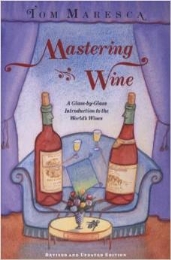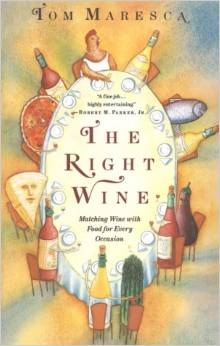Caparone Vineyards, in Paso Robles, continues to impress me mightily. Some time back I wrote in praise of its 2002 Aglianico, Nebbiolo, and Sangiovese, the most delicious and elegant California versions of those varieties I’ve ever tasted. Recently I’ve had the opportunity to taste bottles of the same grapes from the 2014 vintage, and I was almost reduced to a barely articulate Oh wow! (Be assured: My normal verbosity quickly reasserted itself.)
Naturally, these younger wines were not as complex or developed as their older relatives – but the vines are older too, and that adds dimension to even a newly released wine. These were all beautiful specimens of their varieties. They seemed perfectly worthy of standing on the table with the best young examples of their kinds I’ve had in Italy, though patently different from them in the character of their fruit and their balance.
.
Sangiovese
The Sangiovese showed a brilliant light garnet, very pleasing to the eye. The nose came across as all underbrush and fresh red fruit. The palate tasted youthful – bright cherry – with medium body and a lively acid/tannin balance. The overall impression was freshness and elegance, spot-on for young Sangiovese. This wine differed from a young Chianti, for instance, in being not so markedly acid-forward: It was also slightly fuller-bodied, with more generous fruit. The latter quality I think of as quintessential California.
It’s worth noting, since this is a young wine, that it got better and more interesting as it opened in the glass. What it will do with some years of maturity makes for very pleasant speculation. The Caparones aren’t given to exaggeration or over-hyping their wines, but their back label claims that this wine (and its sibling Aglianico and Nebbiolo) “will continue to age for 25 years or more.” I’m not likely to be able to test that statement, but I sure hope some of you will.
It’s also worth noting that the alcohol level of this wine is a modest 13.3 degrees — by current California standards, almost a soft drink.
.
Nebbiolo
I enjoyed the Nebbiolo just as much, but it was an animal of different stripe. Its color was a pale garnet, with a thin orange edge, perhaps to an eye unused to Nebbiolo suggesting it’s already old and fading. Far from it: this wine was an infant, tasting of fresh berries (strawberries kept peeping out) and earth. It had good acidity and very soft tannins, with low – by California standards, very low – alcohol: 13 degrees – and a long licorice and leather finish. But what really grabbed my attention right from the start was the aroma: Damned if it didn’t smell delicately of tar and dried roses and earth. That’s textbook Alba Nebbiolo, folks, and I am in awe of a New World wine capturing that quality of this great, cantankerous grape.
.
One major difference between Caparone’s Nebbiolo and any young Barolo or Barbaresco I’ve experienced: No Piedmont Nebbiolo would be as pleasant drinking as this wine at first release. In many vintages, a Piedmont Nebbiolo’s tannins would rip your throat out. Even 2004, which was – and is – a great vintage and a very forward one, was much sterner and more sharply tannic at a comparable age. We’ve all always assumed that such early toughness was a necessary concomitant to the structure that made long aging possible – but if David and Marc Caparone are right about the aging potential of their wine, then received wisdom has been dead wrong about that. And that should give us all – consumer, critics, and producers alike – a lot to think about.
.
Aglianico
The 2014 Aglianico certainly gave me a lot to think about. The darkest, most deeply colored of the three varieties, it also had the most intense aroma: earth, toasted nuts (hazel? almond?), and rich, black, plummy fruit. The earth and black plum flavors emphatically followed through on the palate – just huge fruit flavors, understrapped by lovely acid/tannin balance. The tannins were abundant, but soft, making a well-structured and long-finishing wine, but also a very accessible, enjoyably drinking wine, even so young.
With food, the flavor components rounded and broadened and deepened remarkably, revealing an extraordinary balance and structure, yet still soft and open. Diane and I were bowled over: We thought this a wine destined for greatness. And, oh, by the way, it was only 13 degrees of alcohol, which ought to be a slap in the face of all those overblown California wines that substitute big alcohol for any real winemaking quality.
.
I’ve never particularly wanted to live to any great age, but the way the Caparones make wine is causing me to think again about that. .

Dave Caparone at his tasting room, with Tom’s whilom student and old friend Magda Gilewicz. Photo by Mike Chen
.






I found out about this great winery many years ago and have been a member of their wine club since then. By far, the best 100% Italian varietals plus great Cabs, Merlots and Zinfandels (all 100% varietals)…!
Thank you for the article and thank you for those who posted comments. I know where to visit the next time we are in California. I am particularly interested in the report on the aglianico grape as my experience is that it seems to thrive best near volcano areas (Vesuvio, Vulture, Roccamonfino); with the exception of Cilento area, which also produces excellent aglianico wines. There must be similarity in the land and climate of Caparone and Cilento areas. Thanks to all again.
Wonderful post, Tom. In addition to being fortunate to live close enough to make trips to Caparone winery when the wine rack gets empty, to get CA wines that you are so enthusiastic about is a joyous gift. I also love the note, the hint, the subtle taste of nostalgia about the future bottled in your piece. You don’t wax nostalgic or sentimental in your robust writing, but here you sound very lyrical–like those wines…? Now, down to earth, what would be the best dishes to pair these wines with in your and Diane’s opinion?
Thanks for the compliments, Magda: I remember that you were always very sensitive to style. As to dishes to pair those young wines with: Because they are young and still fruit-dominated, they are actually very versatile with foods. Too big for most fish dishes, of course, but they could deal with chicken and almost any meats, broiled, roasted, braised, etc. They loved mushrooms, and did well even with tomato sauces. Brown sauces were their metier, of course — but really, I think you can just let common sense be your guide. I’m not sure how they would behave with strong Asian spicings, but it might be interesting to try: they all have good acidity, which makes them very food-adaptable. Buon appetito!
I am fortunate enough to have tasted Caparone’s Italian-varietal wines,and I agree with you 100 per cent. Caparone clearly is the best producer of Italian varietal wines n California, hands down. Any Italian wine lover visiting in the Paso Robles area should visit Caparone and taste their wines. All three varieties you mention are THE BEST Italian varietal wines i have tasted outside of Italy. For me, the Caparone Aglianico is their best, followed by their Sangiovese, I also liked their Nebbiolo, the most difficult veriety to produce outside of Piedmont.